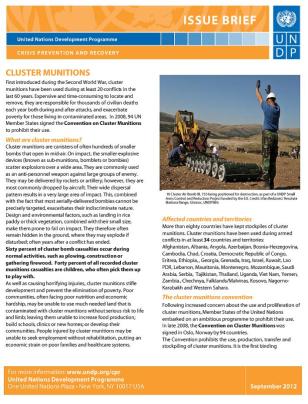Issue Brief Cluster Munitions

English
DownloadIssue Brief Cluster Munitions
November 22, 2015
First introduced during the Second World War, cluster munitions have been used during at least 20 conflicts in the last 60 years. Expensive and time-consuming to locate and remove, they are responsible for thousands of civilian deaths each year both during and after attacks, and exacerbate poverty for those living in contaminated areas. In 2008, 94 UN Member States signed the Convention on Cluster Munitions to prohibit their use.
Cluster Munitions are canisters of often hundreds of smaller bombs that open in mid-air. On impact, the smaller explosive devices (known as sub-munitions, bomblets or bombies) scatter explosions over a wide area. They are commonly used as an anti-personnel weapon against large groups of enemies. They may be delivered by rockets or artillery; however, they are most commonly dropped by aircraft. Their wide dispersal pattern results in a very large area of impact. This, combined with the fact that most aerial-delivered bombies cannot be precisely targeted, exacerbates their indiscriminate nature. Design and environmental factors, such as landing in rice paddy or thick vegetation, combined with their small size, make them prone to fail on impact. They therefore often remain hidden in the ground, where they may explode if disturbed; often years after a conflict has ended.

 Locations
Locations